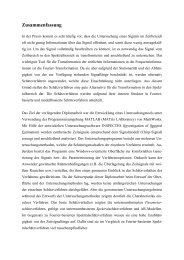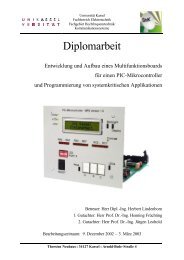DSP Signal Generator Implementation On C6713 DSK - ComLab
DSP Signal Generator Implementation On C6713 DSK - ComLab
DSP Signal Generator Implementation On C6713 DSK - ComLab
Create successful ePaper yourself
Turn your PDF publications into a flip-book with our unique Google optimized e-Paper software.
1.2 <strong>Signal</strong> <strong>Generator</strong><br />
The signal generator is referred to a wide range of devices used to test electronic equipments by<br />
generating a signal whose frequency, wave shape, and amplitude are independently adjustable<br />
over a wide range of settings [9].<br />
<strong>Signal</strong> generator come in many different forms. The most prevalent signal generator types<br />
include function generator and arbitrary waveform generator. The signal generator types vary in<br />
their feature and functionality (and at varying level of expense) and are suitable for many<br />
different applications; in general, no single device is suitable for all possible applications [10].<br />
1.2.1 Function <strong>Generator</strong><br />
Function generators create built-in waveforms, such as sine, square or triangle waves, at<br />
adjustable frequencies and amplitude. Some function generators can also generate white or pink<br />
noise.<br />
Function generators can be either analog or digital based. Analog based function generators use<br />
electrical circuit which is combination of capacitor, resistor, inductors and other hardware to<br />
create simple functions and often they are used when a static sine or square wave at a specified<br />
frequency is required in a certain application.<br />
Digital based function generators use combination of <strong>DSP</strong>, DAC and memory buffer to<br />
dynamically create signals. Many signal generators create signals by dividing an internal<br />
timebase by an integer factor. This is called the divide-by-N method. Divide-by-N clocking,<br />
however, gives a limited set of frequencies. Figure 1.5 shows a basic architecture of digital based<br />
function generators.<br />
6





